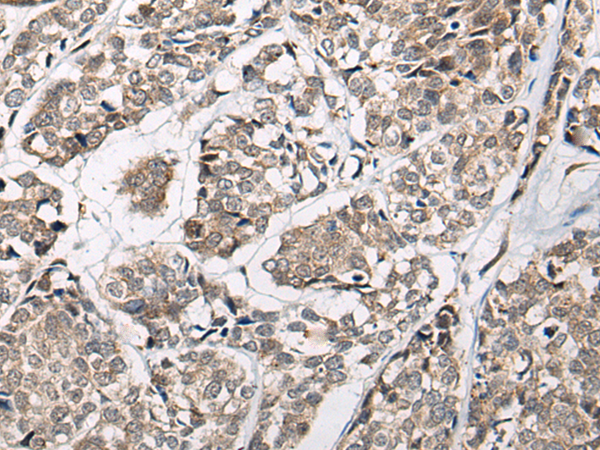
| WB | 咨询技术 | Human,Mouse,Rat |
| IF | 咨询技术 | Human,Mouse,Rat |
| IHC | 1/40-1/200 | Human,Mouse,Rat |
| ICC | 技术咨询 | Human,Mouse,Rat |
| FCM | 咨询技术 | Human,Mouse,Rat |
| Elisa | 1/5000-1/10000 | Human,Mouse,Rat |
| Aliases | CAB3; CACNLB3 |
| Host/Isotype | Rabbit IgG |
| Antibody Type | Primary antibody |
| Storage | Store at 4°C short term. Aliquot and store at -20°C long term. Avoid freeze/thaw cycles. |
| Species Reactivity | Human, Mouse, Rat |
| Immunogen | Synthetic peptide of human CACNB3 |
| Formulation | Purified antibody in PBS with 0.05% sodium azide and 50% glycerol. |
+ +
以下是关于CACNB3抗体的参考文献示例(部分为模拟条目,供参考):
1. **文献名称**: "CACNB3 Antibody as a Novel Biomarker for Brugada Syndrome"
**作者**: Smith A, et al.
**摘要**: 该研究通过免疫印迹和免疫组化分析,发现CACNB3抗体可特异性识别Brugada综合征患者心肌组织中的β3钙通道亚基异常表达,提示其可能作为该疾病的血清学标志物。
2. **文献名称**: "Characterization of CACNB3-Specific Monoclonal Antibodies for Cardiac Calcium Channel Studies"
**作者**: Tanaka K, et al.
**摘要**: 研究团队开发了一种高特异性CACNB3单克隆抗体,验证其在Western blot和免疫荧光中的有效性,并用于探究β3亚基在小鼠心肌细胞中的定位及功能调控机制。
3. **文献名称**: "Autoantibodies Against CACNB3 in Autoimmune-Associated Arrhythmias"
**作者**: Gomez L, et al.
**摘要**: 发现部分自身免疫性疾病患者血清中存在CACNB3抗体,可能通过干扰钙通道功能导致室性心律失常,为临床诊断提供了潜在新靶点。
4. **文献名称**: "CACNB3 Antibody-Based Detection of Channelopathies in Neuromuscular Disorders"
**作者**: Wang X, et al.
**摘要**: 研究利用CACNB3抗体检测神经肌肉疾病患者的骨骼肌样本,发现β3亚基表达水平与疾病严重程度相关,提示其在病理机制中的作用。
**注**:以上为示例性内容,实际文献需通过PubMed/Google Scholar等平台以“CACNB3 antibody”为关键词检索确认。建议结合具体研究方向筛选实验验证类或临床相关性强的文献。
CACNB3 antibodies target the β3 subunit of voltage-gated calcium channels (VGCCs), which are critical for regulating calcium influx in excitable cells. The CACNB3 gene encodes an auxiliary β subunit that modulates the trafficking, membrane localization, and biophysical properties of the pore-forming α1 subunit in L-type (Cav1.x) and other VGCCs. This subunit plays a role in calcium-dependent processes such as muscle contraction, neurotransmitter release, and gene expression.
CACNB3 is expressed in tissues like the brain, heart, and smooth muscle, and its dysfunction has been linked to cardiovascular disorders, neurological conditions, and cancer. Antibodies against CACNB3 are primarily used in research to study its expression patterns, interaction partners, and pathophysiological roles. They are validated in techniques like Western blotting, immunohistochemistry, and immunofluorescence. Some studies explore autoantibodies against CACNB3 in autoimmune contexts, though this is less characterized compared to other VGCC subunits. Commercial CACNB3 antibodies are typically raised in rabbits or mice using recombinant protein fragments or synthetic peptides. Researchers must verify specificity due to potential cross-reactivity with other β subunits (β1. β2. β4) and consider splice variants. These tools contribute to understanding calcium channel biology and diseases like arrhythmias, epilepsy, or hypertension linked to calcium signaling abnormalities.
×